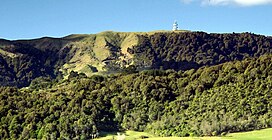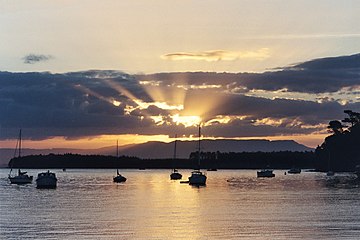Kaimai Range
| Kaimai Range | |
|---|---|
 Kaimai Range with communications towers | |
| Highest point | |
| Elevation | 953 m (3,127 ft) |
| Coordinates | 37°32′01″S 175°44′33″E / 37.533654°S 175.742412°E[1] |
| Geography | |
| Geology | |
Ma | |
| Mountain type | Mostly andestic and some rhyolitic formations |
| Type of rock | Predominantly andesite and rhyolite volcanics |
| Volcanic arc | Coromandel Volcanic Zone |
| Last eruption | 1.53 million years ago |
| Climbing | |
| Easiest route | State Highway 29 (New Zealand) (North-South track, Hendersons Tramline, Ngamuwahine track)[1] |
| Normal route | State Highway 2 (New Zealand) (Mount Karangahake Walk, Waitawheta Pipeline Walk and most eastern tracks)[1] |
| Access | As well as above State Highway 26 (New Zealand) (Te Arohoa track), Te Arohoa Gordon Road, Old Te Arohoa Road (Te Tuhi track) and State Highway 24 (New Zealand)[1] |

The Kaimai Range (sometimes referred to as the Kaimai Ranges) is a mountain range in the North Island of New Zealand. It is part of a series of ranges, with the Coromandel Range to the north and the Mamaku Ranges to the south. The Kaimai Range separates the Waikato in the west from the Bay of Plenty in the east.
The highest point of the range is Mount Te Aroha (953 m), at the foot of which is the town of
. Mt Te Aroha can be described as the northern head peak of the Kaimai Range.The New Zealand Ministry for Culture and Heritage gives a translation of "eat fermented food" for Kaimāī.[2]
The Kaimai Ranges feature in local Māori folklore. The name Te Aroha translates from Māori as Te - The & Aroha - Love. Literally "the love". The name comes from a Māori legend that the sun god - male - loved the moon goddess - female. They never could see each another due to the planets positions. One day the moon goddess came to earth to see the sun god, knowing the risks, was turned to stone as the daylight came. Hers was the ultimate expression of love: Te Aroha in Māori. This is why on the Kaimai Range, to the right of Mt Te Aroha is a high skyline silhouetted rock that from afar is shaped as a woman. It is known locally as the rock of Hinemoa.
Within the Kaimai Ranges the Hendersons Tramline loop track follows the route of bush tramlines and haul lines once used to extract logs from the bush. The walk includes forest and clearings near the fringe of the park. A side track off the main walk leads down to the base of a waterfall and a large swimming hole. Also some 10–16 km, on the Gordon backroad from te Aroha is a four-wheel drive track named Thomsons track, that takes venturers from the foothills around manawaru to the ranges top, where a large swimming hole is present.
Geology and history
The Kaimai Range is the result of a fault that uplifted primarily
Demographics
Kaimai statistical area, which does not include the entire range, covers 327.89 km2 (126.60 sq mi)[5] and had an estimated population of 2,390 as of June 2023,[6] with a population density of 7.3 people per km2.
| Year | Pop. | ±% p.a. |
|---|---|---|
| 2006 | 1,701 | — |
| 2013 | 1,752 | +0.42% |
| 2018 | 2,028 | +2.97% |
| Source: [7] | ||
Kaimai had a population of 2,028 at the
Ethnicities were 94.4% European/Pākehā, 12.4% Māori, 1.0% Pacific peoples, 1.3% Asian, and 2.2% other ethnicities. People may identify with more than one ethnicity.
The percentage of people born overseas was 15.1, compared with 27.1% nationally.
Although some people chose not to answer the census's question about religious affiliation, 60.2% had no religion, 29.7% were Christian, 0.6% had Māori religious beliefs, 0.1% were Buddhist and 0.9% had other religions.
Of those at least 15 years old, 273 (17.0%) people had a bachelor's or higher degree, and 252 (15.7%) people had no formal qualifications. The median income was $36,800, compared with $31,800 nationally. 309 people (19.3%) earned over $70,000 compared to 17.2% nationally. The employment status of those at least 15 was that 915 (57.1%) people were employed full-time, 276 (17.2%) were part-time, and 42 (2.6%) were unemployed.[7]
Kaimai Tunnel
The
A peak of the Kaimai directly above the tunnel, previously unnamed, was named Stokes Peak in 2010 in honour of geographer Evelyn Stokes.[8]
Flight 441 disaster
At approximately 9:09 am on 3 July 1963 the
Communications
The
The New Zealand Broadcasting Corporation (NZBC) commissioned a television broadcast relay station atop Mount Te Aroha in 1963, relaying Auckland's AKTV2 channel (now part of TVNZ 1) to Hamilton and Tauranga.[11] Today, Mount Te Aroha is the main television transmitter and one of two main FM radio transmitters (along with Ruru) serving the Waikato.
See also
- Tunnels in New Zealand
- Matamata-Piako District
- Western Bay of Plenty District
- Ohinemuri River
References
- ^ a b c d e NZTopoMap Te Aroha
- ^ "1000 Māori place names". New Zealand Ministry for Culture and Heritage. 6 August 2019.
- Wikidata Q58677392.
- Wikidata Q58677411.
- ^ "ArcGIS Web Application". statsnz.maps.arcgis.com. Retrieved 10 December 2022.
- ^ "Population estimate tables - NZ.Stat". Statistics New Zealand. Retrieved 25 October 2023.
- ^ a b "Statistical area 1 dataset for 2018 Census". Statistics New Zealand. March 2020. Kaimai (191400). 2018 Census place summary: Kaimai
- ^ Stokes Peak Archived 2014-01-10 at the Wayback Machine, Land Information New Zealand, retrieved 2010-09-09.
- ^ "New Zealand's worst air disasters". New Zealand Herald. 28 November 2008. Retrieved 21 January 2009.
- ^ "Accident description". Aviation Safety Network. Retrieved 21 January 2009.
- ^ "Parliamentary Debates (Hansard)". Vol. 351. New Zealand Parliament. 28 June 1967. p. 1394.
- ^ "ENR 1.6 - ATS Surveillance Services and Procedures" (PDF). Aeronautical Information Publication New Zealand. Retrieved 20 August 2022.

